(完整版)现在完成时趣味讲解
- 格式:doc
- 大小:13.55 KB
- 文档页数:4
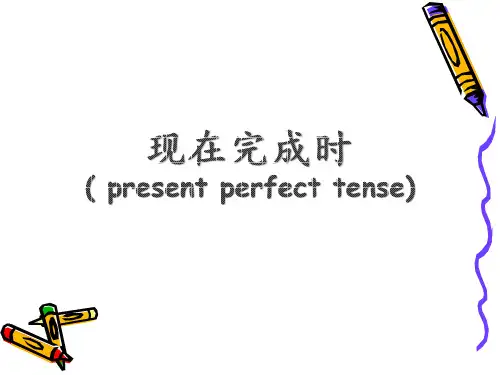
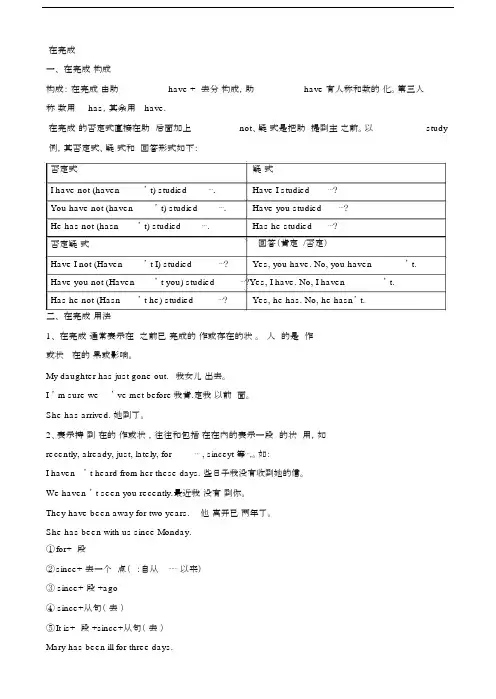
在完成一、在完成构成构成:在完成由助have + 去分构成,助have 有人称和数的化。
第三人称数用has,其余用have.在完成的否定式直接在助后面加上not、疑式是把助提到主之前。
以study 例,其否定式、疑式和回答形式如下:否定式疑式I have not (haven ’ t) studied ⋯. Have I studied ⋯?You have not (haven ’ t) studied ⋯. Have you studied ⋯?He has not (hasn ’ t) studied ⋯. Has he studied ⋯?否定疑式回答(肯定 /否定)Have I not (Haven ’ t I) studied ⋯? Yes, you have. No, you haven ’ t.Have you not (Haven ’ t you) studied ⋯?Yes, I have. No, I haven ’ t.Has he not (Hasn ’ t he) studied ⋯? Yes, he has. No, he hasn’ t.二、在完成用法1、在完成通常表示在之前已完成的作或存在的状。
人的是作或状在的果或影响。
My daughter has just gone out.我女儿出去。
I ’ m sure we’ ve met before我肯.定我以前面。
She has arrived. 她到了。
2、表示持到在的作或状,往往和包括在在内的表示一段的状用,如recently, already, just, lately, for⋯, sinceyt等⋯,。
如:I haven’ t heard from her these days.些日子我没有收到她的信。
We haven ’ t seen you recently.最近我没有到你。
They have been away for two years.他离开已两年了。

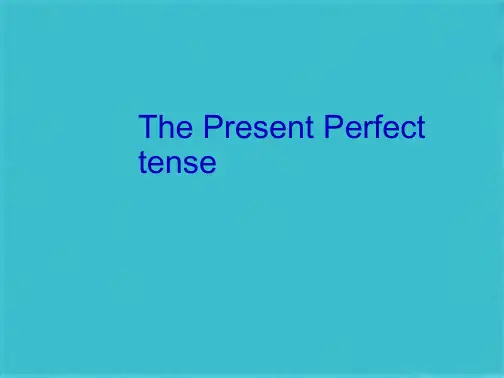
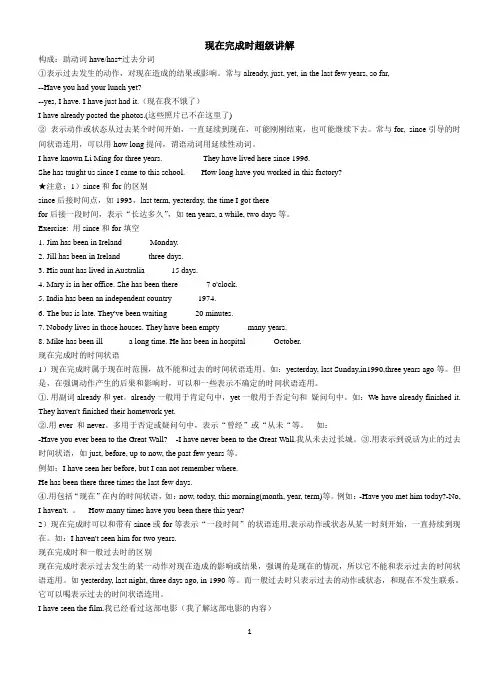
现在完成时超级讲解构成:助动词have/has+过去分词①表示过去发生的动作,对现在造成的结果或影响。
常与already, just, yet, in the last few years, so far,--Have you had your lunch yet?--yes, I have. I have just had it.(现在我不饿了)I have already posted the photos.(这些照片已不在这里了)②表示动作或状态从过去某个时间开始,一直延续到现在,可能刚刚结束,也可能继续下去。
常与for, since引导的时间状语连用,可以用how long提问,谓语动词用延续性动词。
I have known Li Ming for three years. They have lived here since 1996.She has taught us since I came to this school. How long have you worked in this factory?★注意:1)since和for的区别since后接时间点,如1993,last term, yesterday, the time I got therefor后接一段时间,表示“长达多久”,如ten years, a while, two days等。
Exercise: 用since和for填空1. Jim has been in Ireland ______ Monday.2. Jill has been in Ireland ______ three days.3. His aunt has lived in Australia ______15 days.4. Mary is in her office. She has been there ______ 7 o'clock.5. India has been an independent country ______1974.6. The bus is late. They've been waiting ______ 20 minutes.7. Nobody lives in those houses. They have been empty ______ many years.8. Mike has been ill ______a long time. He has been in hospital ______ October.现在完成时的时间状语1)现在完成时属于现在时范围,故不能和过去的时间状语连用。
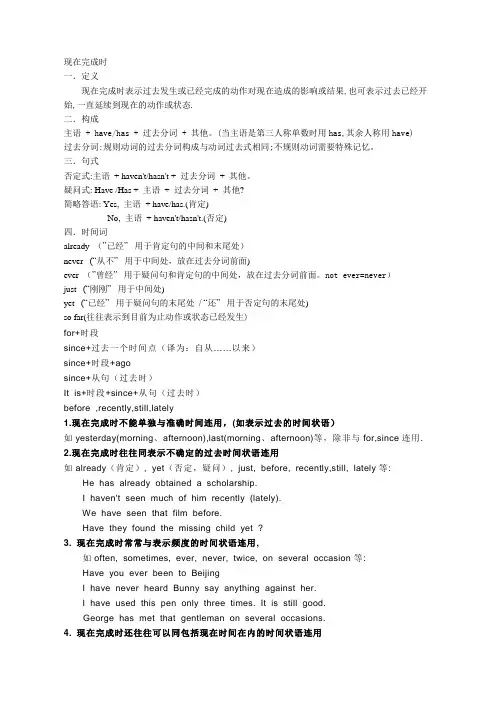
现在完成时一.定义现在完成时表示过去发生或已经完成的动作对现在造成的影响或结果,也可表示过去已经开始,一直延续到现在的动作或状态.二.构成主语 + have/has + 过去分词 + 其他。
(当主语是第三人称单数时用has,其余人称用have) 过去分词:规则动词的过去分词构成与动词过去式相同;不规则动词需要特殊记忆。
三.句式否定式:主语+ haven't/hasn't + 过去分词+ 其他。
疑问式: Have /Has + 主语+ 过去分词+ 其他?简略答语: Yes, 主语+ have/has.(肯定)No, 主语+ haven't/hasn't.(否定)四.时间词already (”已经”用于肯定句的中间和末尾处)never (“从不”用于中间处,放在过去分词前面)ever (”曾经”用于疑问句和肯定句的中间处,放在过去分词前面。
not ever=never)just (“刚刚”用于中间处)yet (“已经”用于疑问句的末尾处/ “还”用于否定句的末尾处)so far(往往表示到目前为止动作或状态已经发生)for+时段since+过去一个时间点(译为:自从……以来)since+时段+agosince+从句(过去时)It is+时段+since+从句(过去时)before ,recently,still,lately1.现在完成时不能单独与准确时间连用,(如表示过去的时间状语)如yesterday(morning、afternoon),last(morning、afternoon)等,除非与for,since连用.2.现在完成时往往同表示不确定的过去时间状语连用如already(肯定), yet(否定,疑问), just, before, recently,still, lately等: He has already obtained a scholarship.I haven't seen much of him recently (lately).We have seen that film before.Have they found the missing child yet ?3. 现在完成时常常与表示频度的时间状语连用,如often, sometimes, ever, never, twice, on several occasion等:Have you ever been to BeijingI have never heard Bunny say anything against her.I have used this pen only three times. It is still good.George has met that gentleman on several occasions.4. 现在完成时还往往可以同包括现在时间在内的时间状语连用如now, up to these few days/weeks/months/years, this morning/week/month/ year, just, today, up to present, so far等:Peter has written six papers so far.Man has now learned to release energy from the nucleus of the atom.There has been too much rain in San Francisco this year.The friendly relations and cooperation between our two countries have been enhanced in the past few years.Up to the present everything has been successful.5. 现在完成时还可以用来表示过去的一个时间到现在这段时间内重复发生的动作.We have had four texts this semester.have been to…表示“去过某地”(表示过去的经历,现在已经回来)have gone to…表示“去了某地”(表示出去了,还没有回来)。


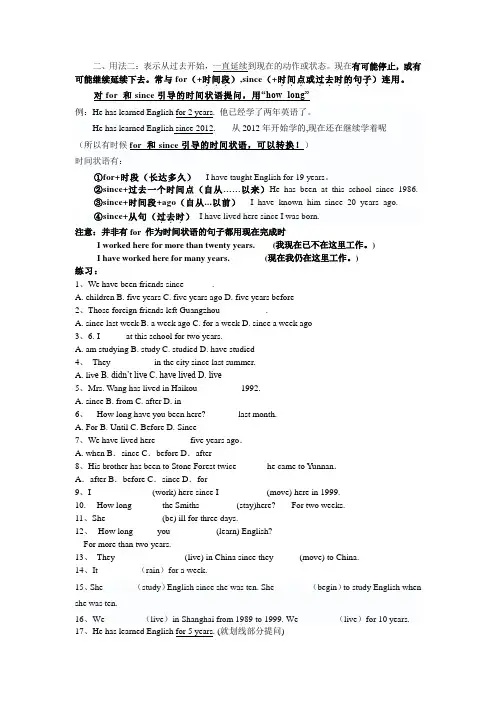
二、用法二:表示从过去开始,一直延续到现在的动作或状态。
现在有可能停止,或有可能继续延续下去。
常与for(+时间段...或过去时的句子......)连用。
...),since(+时间点对for 和since引导的时间状语提问,用“how long”例:He has learned English for 2 years. 他已经学了两年英语了。
He has learned English since 2012. -从2012年开始学的,现在还在继续学着呢(所以有时候for 和since引导的时间状语,可以转换!)时间状语有:①for+时段(长达多久)I have taught English for 19 years。
②since+过去一个时间点(自从……以来)He has been at this school since 1986.③since+时间段+ago(自从...以前)I have known him since 20 years ago.④since+从句(过去时...)I have lived here since I was born.注意:并非有for 作为时间状语的句子都用现在完成时I worked here for more than twenty years. (我现在已不在这里工作。
)I have worked here for many years.(现在我仍在这里工作。
)练习:1、We have been friends since ______.A. childrenB. five yearsC. five years agoD. five years before2、Those foreign friends left Guangzhou __________.A. since last weekB. a week agoC. for a weekD. since a week ago3、6. I _____ at this school for two years.A. am studyingB. studyC. studiedD. have studied4、They _________ in the city since last summer.A. liv eB. didn’t liveC. have livedD. live5、Mrs. Wang has lived in Haikou _________ 1992.A. sinceB. fromC. afterD. in6、---How long have you been here? --- ____ last month.A. ForB. UntilC. BeforeD. Since7、We have lived here _______ five years ago.A. when B.since C.before D.after8、His brother has been to Stone Forest twice ______ he came to Yunnan.A.after B.before C.since D.for9、I _____________ (work) here since I __________ (move) here in 1999.10. ---How long ______ the Smiths ________(stay)here? ---- For two weeks.11、She ____________ (be) ill for three days.12、--How long _____you __________(learn) English?---For more than two years.13、They _______________ (live) in China since they _____ (move) to China.14、It _______(rain)for a week.15、She _______(study)English since she was ten. She _______(begin)to study English when she was ten.16、We _______(live)in Shanghai from 1989 to 1999. We _______(live)for 10 years.17、He has learned English for 5 years. (就划线部分提问)________ ________ ________ _________ learned English ?18、We began to learn English three years ago.(改为同义句)We _______ _______ English ________ three years19、He has lived here since 1999.(就划线部分提问)_____ _____ _____ he_______ here?20、Mr. Li began to teach English in this school in 1999.(同义句)Mr. Li _______ _________ English in this school since 1999.21、The factory opened ten years ago.(同义句)The factory _______ ________ ______ for ten years.22、His company closed in 2003. (同义句)His company _____ _____ _____ _____ 2003.23、We got to know each other for about 15 years. (同义句)We _______ ________ each other _____ about 15 years.三、注意:在现在完成时中与for 和since引导的时间状语,how long连用的动词必须为延续性动词。
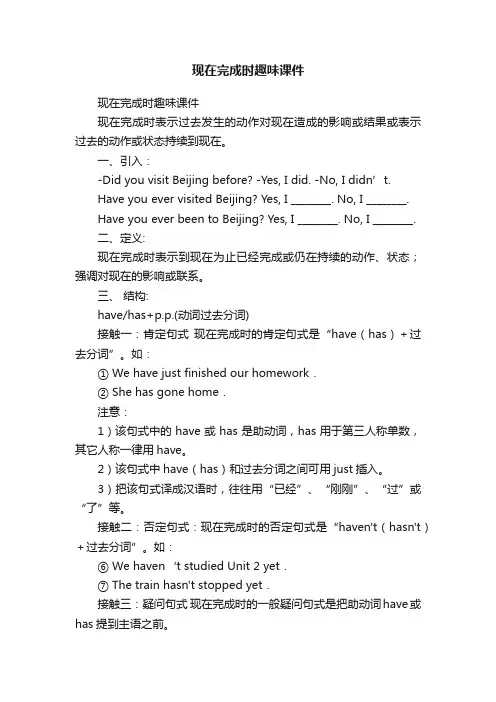
现在完成时趣味课件现在完成时趣味课件现在完成时表示过去发生的动作对现在造成的影响或结果或表示过去的动作或状态持续到现在。
一、引入:-Did you visit Beijing before? -Yes, I did. -No, I didn’t.Have you ever visited Beijing? Yes, I ________. No, I ________.Have you ever been to Beijing? Yes, I ________. No, I ________.二、定义:现在完成时表示到现在为止已经完成或仍在持续的动作、状态;强调对现在的影响或联系。
三、结构:have/has+p.p.(动词过去分词)接触一:肯定句式现在完成时的肯定句式是“have(has)+过去分词”。
如:① We have just finished our homework.② She has gone home.注意:1)该句式中的have或has是助动词,has用于第三人称单数,其它人称一律用have。
2)该句式中have(has)和过去分词之间可用just插入。
3)把该句式译成汉语时,往往用“已经”、“刚刚”、“过”或“了”等。
接触二:否定句式:现在完成时的否定句式是“haven't(hasn't)+过去分词”。
如:⑥ We haven‘t studied Unit 2 yet.⑦ The train hasn't stopped yet.接触三:疑问句式现在完成时的一般疑问句式是把助动词have或has提到主语之前。
③ Have you read this story book yet?特殊疑问句及反意疑问句结构如下:④ What have you done with my bike?⑤ You've read this story book, haven't you?注意:1)现在完成时的一般疑问句往往在句末加yet。

现在完成时讲解一、构成:肯定式:主语+ 助动词have/has + 动词的过去分词.疑问式:助动词Have/Has + 主语+ 动词的过去分词?否定式: 主语+ 助动词have/has + not + 动词的过去分词.过去分词规则变化:a)一般情况下,直接加ed, (work---worked,water---watered, finish---finished 等;)b)以“辅音字母+ y”结尾的动词, 把y 变成i 再加ed, (carry-- -carried study---studied 等;)c)以辅+元+辅结尾且中读的动词,要双写最后一个辅音字母,再加ed。
(stop---stopped,shop---shopped)d)以不发音的e 结尾的动词,只加d(过去分词不规则变化表:二、用法:用法一:表示过去(已经、曾经或从未)发生的某一动作对现在造成的影响或结果。
标志词:①already, ②never, ③ever, ④just, ⑤yet, ⑥before,⑦once/twice/数字+ times例:I have cleaned my room. 我已打扫了房间(房间现在是干净的,不需要打扫了)They have left. --他们已经离开了,也就是说现在他们人不在这里I have never had a car (我从未有过汽车。
)I have been there twice.a)already 往往用于肯定句,用在疑问句时表示强调或加强语气;yet 用于否定句和疑问句。
•He has already left here. 他已经离开这里了。
•Has he already left here? 他(真的)已经离开这里了吗?(表示加强语气)•My teachers haven’t had breakfast yet. 我的老师们还没有吃早饭。
•Have you written to your parents yet? 你已经给你父母写过信了吗?b)never 是否定词,表示“从来没有”,而ever 表示“曾经”•We have never been to the Great Wall. 我们从来没有去过长城。
现在完成时01.意义:9个字已完成持续性影响性学习学到四肢无力已完成指现在看来,已经完成的事情I have finished my homework!我作业写完啦!才寺续‘性指动作发生在过去,并持续了一段时间Tony has lived here for ten years.托尼在这儿住了 10年。
他10年前搬进这个小区,至今有10年了。
影0向'性指动作发生在过去,并对现在产生影响I have lost my wallet. Can you lend me 10 bucks?我钱包丢了。
借我10块好伐?因为我丢了钱包,所以现在没有钱回家,得问你要钱钱。
02.结构从上面3个例句,可见现在完成时的结构:have/has +过去分词用have 还是has,就看主语是单数还是复数。
原则是保持:下面,根据提示,将下列句子变为现在完成时。
1) We(discuss) this issue a few times.主谓一致。
2)Tom and Jerry(know)each other since they were at primary school.3)Dad(just take)the medicine.4)She(not hear)from him.5)you(see)Tony today?03.常用时间状语及其位置for+—段时间since+过去时间点alreadyjust still yetup till now so far a few times>>对比for和since的用法Trevor[came]to the tiny Pacific island a year ago.Trevor[has lived]on the tiny Pacific island for a year.Trevor jhas lived]on the tiny Pacific island since a year ago.Trevor[has lived]on the tiny Pacific island since it came herea year ago.[for+一段时间】指持续了一段时间。
(完整版)现在完成时趣味讲解现在完成时趣味讲解现在完成时的含义可与现在完成时态相连用的常见时间状语瞬间动词在现在完成时态中的用法现在完成时的含义在当今常见的语法书中对现在完成时的定义大多是:现在完成时是指过去发生的至今已经完成或还在继续的动作。
在笔者2011年于《海外英语》中发表的《have + -en的构式研究》中曾指出这一说法的稍欠妥之处。
因为过去发生的“已经完成”或“未完成”容易让学生产生疑惑:究竟是不是完成时?笔者认为易仲良教授提出的“式态”的说法以及马承老师提出的“现在完成时表示过去已经发生而与现在情况有关系的动作”这一说法更能让学生理解。
事实上,我在初中的教学过程当中也是这样跟学生讲解的,学生们能够较好的理解这一说法,并能自然地将现在完成时与一般过去时区分开来。
常与现在完成时相连的时间状语在初中阶段,多数考查现在完成时的句子当中都有较为明显的时间状语标志词,比如以下的这些句子(均摘录自人教版教材):Have you read Treasure Island yet?I’ve already read it.Have you ever been to a museum?I’ve never been to a science museum.I’ve had this bike for three years.如果在实际的教学过程当中孤立地让学生记忆这些时间状语标志,无疑会给学生增大学习难度。
为了能够提高学生的学习兴趣,我认为可以通过口诀韵律的方式让学生较快地掌握:以前(before)从来不(never)出现,最近(recently)曾经(ever)一两遍(once/twice/many times…), 自从(since+时间点)刚刚(just)for一段(for+一段),至今(so far/up to now)已经(already/yet)很明显。
在实际的教学过程当中,教师可有意识地讲述两个“已经”(already/yet)及(since/for)的区别着重分章节讲解,让学生在有了整体概念的基础上对各个考点进行突破。
现在完成时讲解:一.定义:(1)现在完成时态是表示某一已经完成的动作对现在造成的影响和结果。
(已完成用法,强调影响性) 例如:Have you ever visitedthe Place Museum?你参观过故宫博物院吗标志词有:ever曾经,never从未, already已经, , yet还、尚,已经,just,once,three times,before(句末)等。
(2)从过去某一时间延续到现在的动作或情况.(未完成用法,强调持续性)例如:I have worked here for twenty yeaes.我在这儿工作了20年了标志词有:for+时间段,how long, since自从...以来,just, up to now\till now到现在, so far目前in the past/last few years在过去几年,recently/lately最近,近来, 等。
二. 构成:(1)肯定句:have(has)+过去分词(规则动词:与过去式相同+ed,不规则动词:有5种形式:)A-A-A 如:cost—cost—cost; cut—cut—cut; hit—hit—hitA-B-B 如:bring—brought—brought; build—built—built; catch—caught—caught;A-B-C 如:begin—began—begun; blow—blew—blown; drive—drove—drive;A-A-B 如:beat—beat—beatenA-B-A 如:come—came—come不规则动词的过去分词变化规则多,但是还是有一定的规律所循,希望同学们多花心思,细心记下,这是使用完成时态的基础。
(2)疑问句:将have或has提前(3)否定句时直接在其后加notEg I have finished my work.Has he found his car key?三.1)副词already和yetalready一般用于肯定句中,yet一般用于否定句和疑问句中。
现在完成时趣味讲解
现在完成时的含义
可与现在完成时态相连用的常见时间状语
瞬间动词在现在完成时态中的用法
现在完成时的含义
在当今常见的语法书中对现在完成时的定义大多是:现在完成时是指过去发生的至今已经完成或还在继续的动作。
在笔者2011年于《海外英语》中发表的《have + -en的构式研究》中曾指出这一说法的稍欠妥之处。
因为过去发生的“已经完成”或“未完成”容易让学生产生疑惑:究竟是不是完成时?
笔者认为易仲良教授提出的“式态”的说法以及马承老师提出的“现在完成时表示过去已经发生而与现在情况有关系的动作”这一说法更能让学生理解。
事实上,我在初中的教学过程当中也是这样跟学生讲解的,学生们能够较好的理解这一说法,并能自然地将现在完成时与一般过去时区分开来。
常与现在完成时相连的时间状语
在初中阶段,多数考查现在完成时的句子当中都有较为明显的时间状语标志词,
比如以下的这些句子(均摘录自人教版教材):
Have you read Treasure Island yet?
I’ve already read it.
Have you ever been to a museum?
I’ve never been to a science museum.
I’ve had this bike for three years.
如果在实际的教学过程当中孤立地让学生记忆这些时间状语标志,无疑会给学生增大学习难度。
为了能够提高学生的学习兴趣,我认为可以通过口诀韵律的方式让学生较快地掌握:以前(before)从来不(never)出现,最近(recently)曾经(ever)一两遍(once/twice/many times…), 自从(since+时间点)刚刚(just)for一段(for+一段),至今(so far/up to now)已经(already/yet)很明显。
在实际的教学过程当中,教师可有意识地讲述两个“已经”(already/yet)及(since/for)的区别着重分章节讲解,让学生在有了整体概念的基础上对各个考点进行突破。
瞬间动词在现在完成时中的用法
在人教版的课本附录的语法讲解中,我们可以看到:“某些动词的现在完成时可表示过去某一时间开始并一直持续到现在(包括”现在“在内)的动作或状态,可以和表示延续的时间状语连用。
表示持续动作或状态的动词多是延续性动词”。
如:
I have known Bob for three years.
They have lived here since 1996.
She has taught us since I came to this school.
但在实际的语言运用过程当中,有很多的非延续性动词也有需要用于“过去已经发生对现在有影响”这一时态用法中,比如“我买这台自
行车已经三年了”;“我借这本书两个星期了”等等。
在这种情况下,作为老师,或许我们首先是要向学生们讲明:1.区分延续性动词与非延续性动词;(非延续性动词表达的动作暗含了状态改变的临界点,如die, marry and open)
2. 非延续性动词可以用于现在完成时中,只是不能和表示延续的时间状语连用。
如: I have just arrived here. (我刚刚到这。
正确) I have arrived here for three minutes. (我到这三分钟了。
错误)
3.常见的非延续性动词如果要表达一个延续的概念时,应该怎样转变:我在教学的过程中,用的是一种故事法,先通过一个有趣的故事让学生明确哪些是常见的非延续性动词,然后再将故事中的非延续性动词一一转化为延续性动词,以便学生学生做题。
故事如下:
有一个男孩,来(come)来(arrive)去(go)去(leave)遇到一个姑娘,然后他们就结婚(marry),随后男孩参(join)军,上战场后不幸死(die)了,姑娘借(borrow)钱给男孩买(buy)棺材,姑娘打开(open)棺材开始(begin)哭了起来。
在学生能清晰地记住这些常见的非延续性动词之后,再将这些非延续性动词与延续性动词的转化表格一一讲解:
come/arrive-------have been in
go/leave-------have been away from
marry------have been married
join------have been a member of
die-----have been dead
borrow------have kept
buy------have had
open------have been open
begin------have been on
学生通过故事联想法能够将常见的非延续性动词记忆清楚,并在老师的帮助下学会做题。
结语:实际的教学过程当中,通过这样的故事及口诀的方法,也许更能调动学生的积极性,激发学生兴趣。